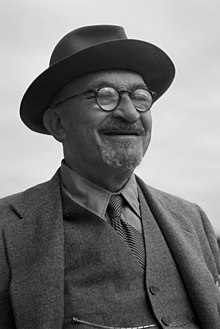Chaim Weizman
| Chaim Weizmann חיים עזריאל ויצמן |
|
|---|---|
 |
|
| 1st President of Israel | |
|
In office 17 February 1949 – 9 November 1952 |
|
| Prime Minister | David Ben-Gurion |
| Preceded by | Himself (as Chairman of the Provisional State Council) |
| Succeeded by | Yitzhak Ben-Zvi |
| 2nd Chairman of the Provisional State Council of Israel | |
|
In office 16 May 1948 – 17 February 1949 |
|
| Prime Minister | David Ben-Gurion |
| Preceded by | David Ben-Gurion |
| Succeeded by | Himself (as President) |
| Personal details | |
| Born |
Chaim Azriel Weizmann 27 November 1874 Motal, Russian Empire (Now Belarus) |
| Died | 9 November 1952 (aged 77) Rehovot, Israel |
| Nationality | Israeli-British |
| Political party | General Zionists |
| Spouse(s) | Vera Weizmann |
| Relations | Maria (Masha) Weizmann, Dr. Anna (Anushka) Weizmann, Prof. Moshe Weizmann, Shmuel Weizmann – siblings |
| Children | |
| Alma mater |
Technical University of Darmstadt Technical University of Berlin University of Fribourg |
| Profession | Chemist |
| Signature | |
Chaim Azriel Weizmann (Hebrew: חיים עזריאל ויצמן Hayyim Azri'el Vaytsman, Russian: Хаим Вейцман Khaim Veytsman; 27 November 1874 – 9 November 1952) was a Zionist leader and Israeli statesman who served as President of the Zionist Organization and later as the first President of Israel. He was elected on 16 February 1949, and served until his death in 1952. Weizmann convinced the United States government to recognize the newly formed state of Israel.
Weizmann was also a biochemist who developed the acetone–butanol–ethanol fermentation process, which produces acetone through bacterial fermentation. His acetone production method was of great importance for the British war industry during World War I. He founded the Weizmann Institute of Science in Rehovot, Israel and was instrumental in the establishment of the Hebrew University of Jerusalem.
Weizmann was born in the village of Motal, located in what is now Belarus and at that time part of the Russian Empire. He was the third of 15 children born to Oizer and Rachel Czemerinsky Weizmann. His father was a timber merchant. From ages four to eleven, he attended a traditional cheder, or Jewish religious elementary school, and he began studying Hebrew as a child. At the age of 11, he entered high school Pinsk, where he displayed a talent for science, especially chemistry. While in Pinsk, he also became active in the Hovevei Zion groups there. He graduated with honors in 1892, and decided to pursue chemistry as a profession.
...
Wikipedia
